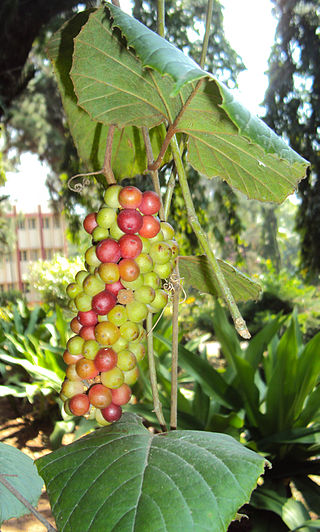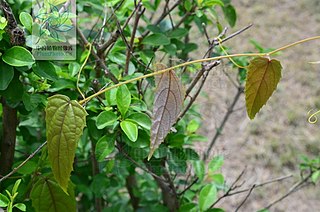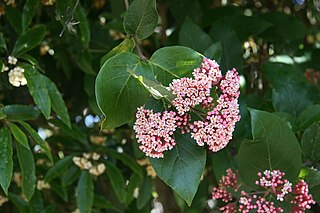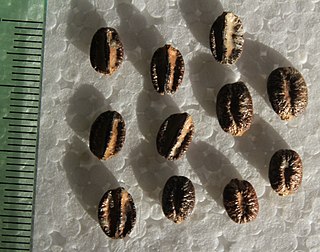
Thespesia is a genus of 14 flowering shrubs and trees in the Hibiscus family, Malvaceae, although within the family they are more closely related to cotton plants (Gossypium). The genus is distributed from the South Pacific through Asia, Africa, and the Caribbean.

Actinidia arguta, the hardy kiwi or kiwiberry, is a perennial vine native to Japan, Korea, Northern China, and the Russian Far East. It produces a small kiwifruit without the hair-like fiber covering the outside, unlike most other species of the genus.

Jules Émile Planchon was a French botanist born in Ganges, Hérault. He was a brother of Gustave Planchon who also studied medicinal plants.

The Great French Wine Blight was a severe blight of the mid-19th century that destroyed many of the vineyards in France and laid waste to the wine industry. It was caused by an insect that originated in North America and was carried across the Atlantic in the late 1850s. The actual genus of the insect is still debated, although it is largely considered to have been a species of Daktulosphaira vitifoliae, commonly known as grape phylloxera. While France is considered to have been worst affected, the blight also did a great deal of damage to vineyards in other European countries.

Ampelocissus is a genus of Vitaceae having 90 or more species found variously in tropical Africa, Asia, Central America, and Oceania. The type species, A. latifolia, was originally treated under its basionym, Vitis latifolia, and was collected from the Indian subcontinent.

Vitis davidii is a species of vining plant native to Asia. The plant grows to a height of up to 8 m (25 ft) and bears small, black grapes. It is also known as the Chinese bramble grape.

Karwinskia is a genus of flowering plants in the family Rhamnaceae.

Vitis coignetiae, called crimson glory vine, is a plant belonging to the genus Vitis that is native to the temperate climes of Asia, where it can be found in the Russian Far East, (Sakhalin); Korea; and Japan. It was described botanically in 1883. It is called meoru (머루) in Korean and yama-budo (ヤマブドウ) in Japanese.
Vitis adenoclada is a species of plant in the grape family. It is found in the province of Hunan in China, where the climate is temperate.

Vitis shuttleworthii is a North American liana in the grape family commonly known as the calloose grape or bear grape. The name refers to the group of Native American people that resided in southwest Florida, the Calusa. It is native to south and central Florida, with isolated populations in southern Alabama.
Vitis blancoi is a species of liana in the grape family which bears black berries, and is native to western Mexico.
Vitis nesbittiana is a species of liana in the grape family. It is native to central Mexico (Veracruz).
Ampelocissus barbata is a species of liana in the grape family Vitaceae. It was originally described from Sylhet by Nathaniel Wallich and placed in the genus Vitis. The species was moved to Ampelocissus by Jules Émile Planchon in 1884.

Vitis tsoii is a species of wild grape in the family Vitaceae. It is native to the provinces of Fujian, Guangdong, and Guangxi in China, where the climate is temperate.

Vitis monticola, commonly known as mountain grape, or sweet mountain grape, is a North American species of wild grape native to Texas. It is important to grape growers for its resistance to drought; a quality exploited both genetically in hybridization, and in grafting.
Vitis xunyangensis is an Old World species of wild grape native to temperate China.

Abronia, the sand-verbenas or wild lantanas, is a genus of about 20 species of annual or perennial herbaceous plants in the family Nyctaginaceae. Despite the common names, they are not related to Verbena (vervains) or lantanas in the family Verbenaceae. They are closely allied with Tripterocalyx.

Blitum is a genus of flowering plants in the amaranth family Amaranthaceae, subfamily Chenopodioideae. It is closely related to genus Spinacia. Its 12 species were traditionally placed in the genera Chenopodium, Monolepis, or Scleroblitum. The species of genus Blitum occur in Asia, Europe, North Africa, the Americas, and Australia.

Rogiera amoena is a shrub or small tree in the family Rubiaceae, sometimes grown as an ornamental plant. Common names include rondeletia and yellowthroat rondeletia. The species is native to Mexico, Belize, Guatemala, El Salvador, Nicaragua, Costa Rica and Panama.

Ampelocissus martini is a species of climber or shrub in the Vitaceae family. Some sources use the spelling Ampelocissus martinii. It is native to an area of Mainland Southeast Asia. The fruit are eaten by people and by several species of Pangasiidae shark catfish of the Mekong river.















